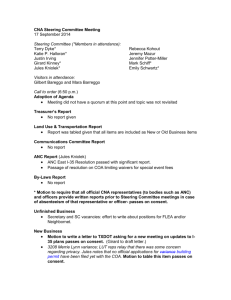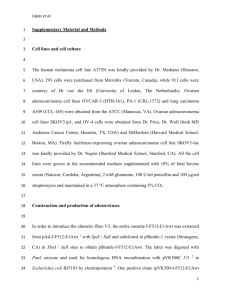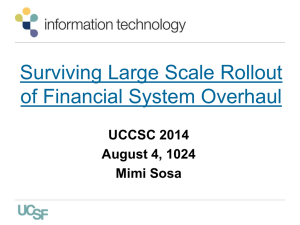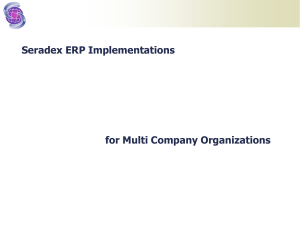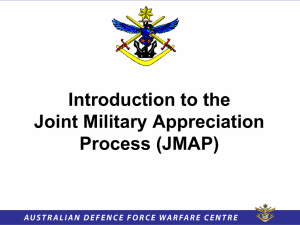Linking Budget Classification and Chart of Accounts
advertisement
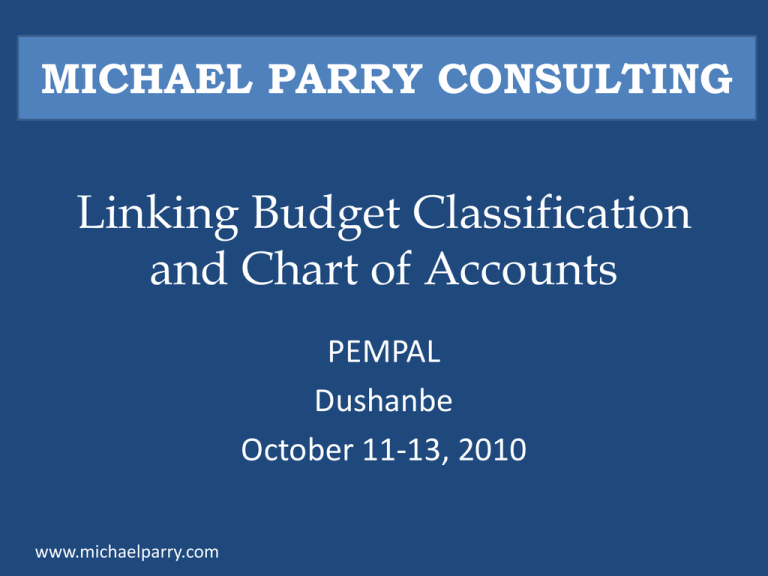
MICHAEL PARRY CONSULTING Linking Budget Classification and Chart of Accounts PEMPAL Dushanbe October 11-13, 2010 www.michaelparry.com Overview Planning Financial Reporting Budget Cycle Budget Budget Execution Accounting Budget Classification Chart of Accounts Interface Budget classification > coding structure for budget Functions: • Legal structure of the budget • Enables multidimensional budget analysis • Basis for budget management and execution Chart of accounts > coding structure for accounting Functions: • Basis of accounting system • Enables multiple transactions to be summarised and reported • Enables financial statements Why do BC and CoA need to interface? Interface 1. Fiscal management – need to manage revenues and expenditures in real time 2. Operational management – need to track commitments and expenditures as compared to budget 3. Financial reporting – IPSAS compliant financial statements must show outturn as compared to budget 4. Control – revenues raised and public money spent in accordance with budget 5. Transparency and accountability – compliance with budget revenue raising and expenditure allocations Traditional approaches to interfacing BC and CoA Budget Classification • Hierarchical administrative coding • Additional codes for economic and functions • Additional codes for other purposes, e.g. Programme, Gender, geographic Chart of Accounts • Administrative coding • Detailed economic codes • Additional codes for assets and liabilities Coding structures mapped for financial reporting • Advantages: • BC and CoA remain separate to meet different requirements • Disadvantages • Very difficult to manage (1 to 1 correspondence between codes) • Not suitable for integrated computer systems Modern approach – integrated BC and CoA Budget Classification • Codes for predicted (ex ante) flows: • Revenues • Expenditure • Financing Chart of Accounts • Uses identical codes to BC to record actual (ex post) flows • Additional codes to record assets and liabilities (more extensive coding of assets and liabilities required under accrual accounting) Obvious solution: • But presents multiple challenges Challenges of integrated BC and CoA • Designing the integrated BC/CoA • Cash based budget with accrual or modified accrual accounting • Institutional issues • Systems to handle new structure • Change management Designing the integrated BC/CoA • IMF GFS Manual Annex 4 provides: – coding structure for functional (COFOG) and economic classification under accrual accounting • But additional codes required for: – Country specific administrative structure – More detailed economic analysis – Special requirements, e.g. Programme codes, gender budgeting – Accounting purposes, e.g. to identify individual loans Example of integrated structure - Tajikistan Category 1 Economic 2 Function Revenue Expenditure Assets & liabilities Net equity GFS revenue GFS expenditure GFS codes Derived from GFS codes Classification of Functions of Government (COFOG) 3 Gov’t organisation Codes specific to organisation of budget entities in Tajikistan 4 Geographic Oblasts and Rayons 5 Fund 6 Programme Gov’t or donor Determined by Gov’t Problems of integrated structure • Complex – many digits – Involves multiple decisions by staff coding transactions – Not feasible to implement with manual systems • Using derived codes may reduce manual workload – E.g. Functional codes derived from administrative structure – But IMF recommends independent codes Cash based budget with accrual or modified accrual accounting Budget - cash based • Flows predicted on cash basis • No coding for non-cash flows, e.g. Depreciation • Capital items expensed when cash paid Accounting – accrual (full or modified) • Flows recorded on accrual basis • Non-cash flows coded • Capital item expensed over useful life Issues: • Requirement to present financial statements comparing budget and actual on same basis (IPSAS 24) – most accounting packages cannot provide required information • Codes for flows in budget not used in accounting and vice versa • Monitoring and control made difficult, e.g. should commitments be recorded on cash or accrual basis? Institutional issues Traditional structure Budget Division Treasury Responsible BC Responsible CoA Integrated BC and CoA Budget Division Treasury Coordinating arrangements to enable joint responsibility for integrated BC/CoA Systems to handle integrated BC/CoA (1) • Typically regional countries – Use spreadsheet or relational database systems for budget preparation – Bespoke (custom developed) systems for accounting • Not normally economically viable to modify existing IT systems for integrated BC/CoA • Hence implementation integrated BC/CoA linked to new IT software Systems for an integrated BC/CoA (2) • Bespoke (custom developed ) systems • Feasible to develop database systems for an integrated BC/CoA • But requires good understanding of financial requirements • many arguments against bespoke systems Commercial Off The Shelf Systems (COTS) • Most commercial accounting packages will not handle complexities of integrated BC/CoA • Requires sophisticated (= expensive) packages • Even with sophisticated packages implementation problems Change management (1) • Implementing an integrated BC/CoA – major change management challenge • Requires: – Training – Systems – Procedures – Documentation – A change plan Options for implementing BC/CoA “Big bang” - simultaneous all budget organisations • Advantages – Organisationally simple – Only one BC/CoA in operation at any time • Disadvantages – High risk – Huge task or preparation at every organisation – Every budget organisations must have new systems, procedures and trained staff at the same time Phased – by geography or by type of budget organisations • Advantages – Reduces risk – Can learn from first phase implementation – New systems, procedures & training can be phased • Disadvantages – Complex to manage – Two separate budget/CoA (with related systems & procedures) operating in parallel Conclusions • It is essential that BC and CoA interface • Complete integration of BC and CoA the logical solution • But presents many problems of design and implementation • There are no “quick fixes” – each issue requires careful consideration and time to resolve


